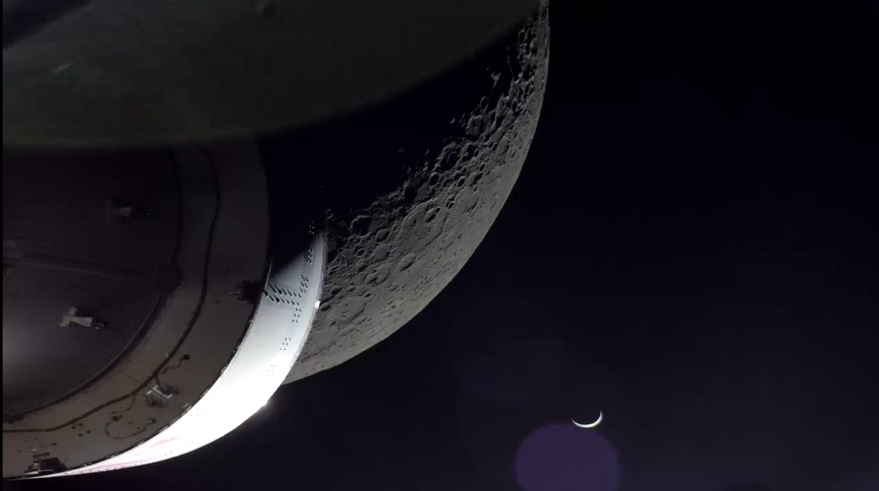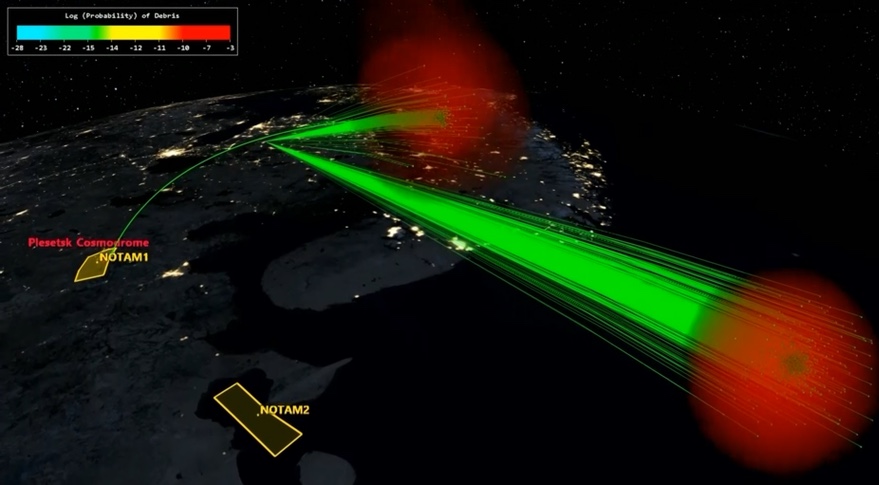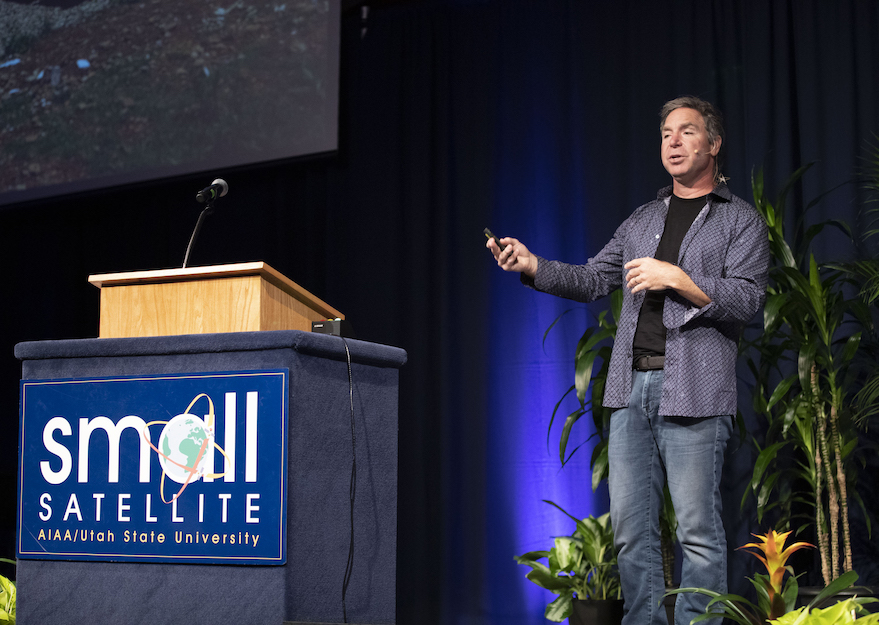U.S. Space Force chief: The use of space technology in Ukraine ‘is what we can expect in the future’
Original Publication Date: 2022-12-04 16:41

Gen. B. Chance Saltzman is chief of space operations of the U.S. Space Force. He says the value of space “has been proven out,” and space is “clearly a contested domain.” The Space Force is working on that, he says, but it will take years.
Orion swings by the moon on its way back to Earth
Original Publication Date: 2022-12-06 10:14

NASA's Orion spacecraft flew by the moon for a second and final time Dec. 5. The maneuver sets up the spacecraft for a splashdown in the Pacific Ocean in six days. Orion, which launched nearly three weeks ago, continues to perform well with only minor problems.
Advisory panel to examine DoD’s demand for commercial space systems
Original Publication Date: 2022-12-05 23:00

Pentagon's top research official has directed the Defense Science Board to examine the military's growing demand for commercial space technology. A central question Shyu wants the panel to address is how DoD should acquire commercial space services. The panel also will look at security threats to space systems as Russia and China are expected to target U.S. Satellites.
Let’s keep an open dialogue on how to protect satellites on orbit - SpaceNews
Original Publication Date: 2022-12-05 21:00

The conflict in Ukraine has shined a light on the policy ambiguity regarding the options available to the U.S. To protect commercial satellites. Recent Chinese and Russian counterspace tests have made it clear that space is no longer a sanctuary. Space protection can and should be fully integrated into the Department of Defense’s broader Joint-All Domain Command and Control Strategy.
E-Space buys RF hardware developer CommAgility
Original Publication Date: 2022-12-05 14:26

E-Space plans to buy radio frequency module developer CommAgility in a $14.5 million deal. CommAgility specializes in systems that manage signals for cellular, air-to-ground, and satellite networks. E-Space plans to integrate CommAgility’s source code into a network of potentially hundreds of thousands of satellites.
Live coverage: Orion spacecraft completes return powered flyby of the moon – Spaceflight Now
Original Publication Date: 2022-12-05 00:00
Live coverage of the flight of the Space Launch System moon rocket and Orion spacecraft on NASA’s Artemis 1 mission. Text updates will appear automatically below; there is no need to reload the page. Follow us on Twitter. Follow us on Facebook and Instagram. Follow us on YouTube.
NASASpaceFlight.com
India launches a new ocean monitoring satellite on Saturday morning. The PSLV rocket delivered the EOS-06 spacecraft into a low Earth orbit. The mission, PSLV C54, lifted off from the Satish Dhawan Space Centre at 11:56 local time (06:26 UTC)
Commercial Archives
Two NASA astronauts conducted a spacewalk outside the International Space Station (ISS) on Saturday, Dec. 2, to install a new iROSA (ISS Roll-Out Solar Array) Installation of the new array marked the third such iROSA to be attached to the space station since a power augmentation program to add at least six new sets of arrays to the ISS began in 2021.
International Archives
A Russian Soyuz-2.1b rocket was launched from Site 43/4 at the Plesetsk Cosmodrome on Dec. 1. Onboard was likely a Lotos-S electronic intelligence satellite for the Russian military. Only Lotos-S1 No. 6 and its Soyuz upper stage were initially cataloged in orbit.
News – Spaceflight101

Russia's Rockot booster set to blast off from Plesetsk Cosmodrome at 17:57 UTC with the Sentinel-3B multi-function satellite. Sentinel-3B is the latest addition to Europe's Copernicus satellite fleet. It will be the third satellite to be launched for the European space agency.
ISS Updates – Spaceflight101 – International Space Station

A veteran NASA spacewalker and an EVA rookie from Japan ended their week with nearly six hours of work outside the International Space Station. The restoration of the Station’s Mobile Servicing System started last year and continued in January to provide Canadarm2 with a new pair of grappling hands.
Featured – Spaceflight101

SpaceX Falcon 9 takes to the skies over Florida’s Cape Canaveral Monday afternoon. The flight-proven Dragon spacecraft will deliver science gear, supplies and maintenance hardware to the International Space Station. It is the first of at least six cargo ships inbound to the U.S. Segment of ISS this year.
Re-Entry: Long March 11 Rocket Body – Spaceflight101

The CZ-11 fourth stage used leftover propellant for a partial de-orbit maneuver, lowering its perigee to 120 Kilometers to significantly accelerate its orbital decay. It is reportedly built around a YF-50 main engine and conducts the orbital circularization after the three CZ-11 stages finish their job.
NASA Is Testing a New Robotic Arm That Really Knows How to Chill Out

The COLDArm system uses gears that require no lubrication or heating to function in the cold. The arm’s cold motor controllers don’t need to be kept warm in an electronics box near the core of the spacecraft. A sensor embedded in COLDArm’s “wrist” gives the arm feedback, allowing it to “feel” what it’s doing in all directions.
VP Harris, French President Get First Look at Galactic Get-Together

James Webb Space Telescope captured this image of a merging galaxy pair. The two galaxies, known as II ZW 96, are 500 million light-years from Earth. The galaxies are in the process of merging and as a result have a chaotic, disturbed shape. II ZW 96 is particularly bright at infrared wavelengths thanks to the presence of star formation.
Baby Star ‘Burps’ Tell Tales of Frantic Feeding, NASA Data Shows

Newborn stars “feed” at a furious rate and grow through surprisingly frequent feeding frenzies. Outbursts from stellar babies at the earliest stage of development occur roughly every 400 years. The first such outburst was detected nearly a century ago, and they’ve rarely been seen since.
NASA’s Lunar Flashlight SmallSat Readies for Launch

Lunar Flashlight will use a new kind of “green’ propellant that is safer to transport and store than the commonly used in-space propellants. One of the mission’s primary goals is to test this technology for future use. The science data collected by Lunar Flashlight will be compared with observations made by other lunar missions.
NASA’s Europa Clipper Gets Its Wheels for Traveling in Deep Space

Europa Clipper is not a life-detection mission, it will conduct a detailed exploration of Europa and investigate whether the icy moon has the capability to support life. Understanding Europa’s habitability will help scientists better understand how life developed on Earth and the potential for finding life beyond our planet.
NASA, ESA Reveal Tale of Death, Dust in Orion Constellation

In between the two hollow regions are orange filaments where dust condenses and forms new stars. Over time, these filaments may produce new giant stars that will once again reshape the region. JPL, a division of Caltech in Pasadena, managed Spitzer mission operations for NASA’s Science Mission Directorate in Washington until the spacecraft was retired in 2020.
Meet the People Behind the SWOT Water-Tracking Satellite

Satellite will be the first to observe nearly all water on Earth’s surface. Led by NASA and the French space agency Centre National d’Études Spatiales (CNES) SWOT will measure the height of water in lakes, rivers, reservoirs, and the ocean.
